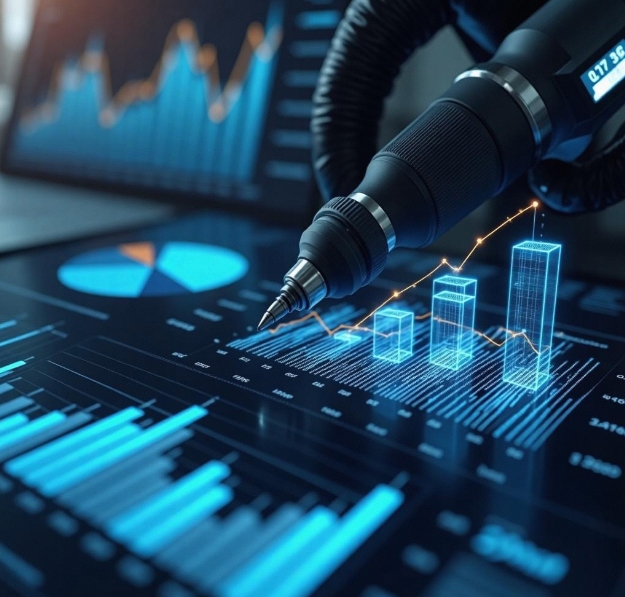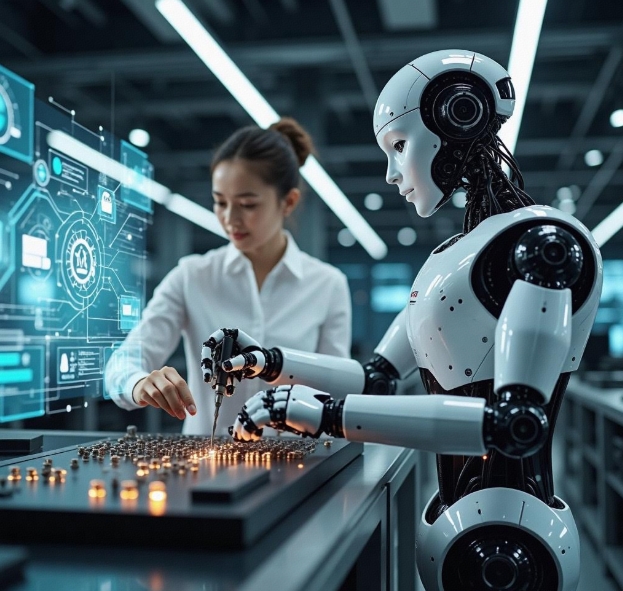Integration and Application of Artificial Intelligence and Robotics
- latest articles
- 1.DApp Development & Customization: Merging Diverse Market Needs with User Experience 2.Analysis of the Core Technical System in DApp Project Development 3.How to achieve cross-chain interoperability in Web3 projects? 4.How does the tokenization of points reconstruct the e-commerce ecosystem? 5.How to Set and Track Data Metrics for a Points Mall? 6.What is DApp Development? Core Concepts and Technical Analysis 7.Inventory of commonly used Web3 development tools and usage tips 8.Development of a Distribution System Integrated with Social E-commerce 9.Six Key Steps for Businesses to Build a Points Mall System 10.What is DApp Development? A Comprehensive Guide from Concept to Implementation
- Popular Articles
- 1.Future Trends and Technology Predictions for APP Development in 2025 2.Analysis of the DeFi Ecosystem: How Developers Can Participate in Decentralized Finance Innovation 3.From Zero to One: How PI Mall Revolutionizes the Traditional E-commerce Model 4.DAPP Development | Best Practices for Professional Customization and Rapid Launch 5.Recommended by the Web3 developer community: the most noteworthy forums and resources 6.From Cloud Computing to Computing Power Leasing: Building a Flexible and Scalable Computing Resource Platform 7.Shared Bike System APP: The Convenient Choice in the Era of Smart Travel 8.How to Develop a Successful Douyin Mini Program: Technical Architecture and Best Practices 9.How to Create a Successful Dating App: From Needs Analysis to User Experience Design 10.From Design to Development: The Complete Process of Bringing an APP Idea to Life
In today's era of rapid technological advancement, the integration of Artificial Intelligence (AI) and robotics has become a significant driving force for human societal progress. Artificial Intelligence simulates human learning, reasoning, and decision-making processes, enabling machines to perform tasks that typically require human intelligence. Robotics, on the other hand, endows machines with physical capabilities through mechanical structures and electronic control systems, allowing them to execute complex operations in specific environments. When these two fields converge, they give rise to a new type of intelligent machine that not only possesses self-learning and adaptive abilities but can also perform various tasks in dynamic and complex environments, even surpassing the operational scope of traditional machines.
This article will delve into the integration of Artificial Intelligence and robotics, analyze its applications and impacts across different fields, and explore the profound implications of this convergence for future societal and economic development.
I. Overview of the Integration of Artificial Intelligence and Robotics
Artificial Intelligence (AI) is a branch of computer science aimed at simulating and realizing human intelligence to enable machines to perform intelligent tasks. It encompasses fields such as machine learning, natural language processing, computer vision, speech recognition, and intelligent decision-making. The development of robotics addresses physical tasks, combining mechatronics, sensor technology, and control systems to enable robots to complete tasks in various environments.
The integration of robotics and Artificial Intelligence is first manifested in the introduction of intelligent algorithms into robotic systems, endowing robots with perception, understanding, and decision-making capabilities. This integration allows robots not only to perform preset actions but also to self-adjust and optimize based on changes in the external environment.
II. Core Technologies in the Integration of AI and Robotics
Perception Technology
The interaction between robots and their environment relies on perception systems. AI's perception technology enables robots to collect external information through sensors (such as cameras, LiDAR, temperature sensors, etc.) and analyze this information using techniques like image recognition and sound processing. This technology allows robots to recognize and understand their surroundings, perceiving information such as object positions, shapes, and movements.Machine Learning and Deep Learning
Machine learning and deep learning are among the core technologies of Artificial Intelligence. Machine learning enables robots to reason and make judgments based on historical experience by learning patterns from data. Deep learning, by constructing neural networks that simulate the workings of the human brain, allows robots to automatically extract features from large datasets, achieving more efficient learning and decision-making. These technologies enable robots to make autonomous decisions in complex environments and even perform self-optimization.Natural Language Processing (NLP)
Natural Language Processing technology enables robots to communicate with humans through language. This technology allows robots to understand, generate, and respond to natural language, facilitating more intuitive and human-like interactions. For example, through speech recognition technology, robots can understand and respond to voice commands from users, thereby completing certain tasks.Reinforcement Learning and Autonomous Decision-Making
Reinforcement learning is an important branch of machine learning that simulates reward and punishment mechanisms, enabling robots to gradually optimize their behavioral strategies while exploring their environment. In complex and dynamic environments, robots can learn optimal action strategies through continuous trial and adjustment. This technology allows robots to make reasonable decisions even when facing unforeseen situations.Robot Control and Coordination Technology
Robot control systems are responsible for converting perceptual information into specific action commands. The integration with AI enables robots to control their movements more precisely. For instance, during complex operations, robots can adjust their action trajectories based on real-time feedback to ensure tasks are completed successfully. Coordination technology in multi-robot systems is also an important direction in robotics, requiring precise communication and coordination mechanisms when multiple robots collaborate to complete tasks.
III. Application Areas of AI and Robotics
The integration of Artificial Intelligence and robotics has had a profound impact across multiple fields, and with technological advancements, its application scope continues to expand.
Manufacturing and Industrial Automation
The application of robots in manufacturing is no longer novel, but with the introduction of AI technology, intelligent production is gradually becoming mainstream. Modern industrial robots can not only perform simple mechanical operations but also autonomously adjust and optimize within complex production lines. For example, AI-driven robots can use vision systems to inspect product quality, adjust production processes in real-time, reduce manual intervention, and improve production efficiency.Healthcare and Nursing
In the medical field, the integration of AI and robotics is gradually transforming traditional healthcare practices. Intelligent surgical robots, such as the Da Vinci Surgical System, provide doctors with more efficient and safe surgical assistance through precise operations. Additionally, AI technology can help robots diagnose diseases, analyze medical images, and recommend personalized treatment plans. Robotic caregivers are also increasingly becoming important assistants to medical staff in nursing homes and hospitals, helping the elderly and patients with daily activities.Service Industry and Home Life
In the service industry, the integration of AI and robotics provides customers with more efficient and personalized services. For instance, service robots in hotels, restaurants, and shopping malls can interact with customers using natural language, offering information, guidance, and delivery services. In home life, intelligent robots like robotic vacuum cleaners and companion robots significantly enhance the quality of life for family members and reduce the burden of household chores.Logistics and Transportation
In the logistics and transportation sector, AI-driven robots are gradually replacing traditional manual operations. Autonomous vehicles and drone delivery are the most typical applications currently. The integration of AI and robotics enables these transport tools to autonomously navigate, avoid obstacles, and plan routes, reducing the need for human intervention and greatly improving transportation efficiency.Military and Security
In the military and security fields, the combination of intelligent robots and AI has been widely applied in weapon systems such as unmanned combat aircraft, unmanned underwater vehicles, and unmanned ground vehicles. These robots can autonomously perform tasks like reconnaissance, strikes, and bomb disposal, protecting soldiers' lives in high-risk environments.Education and Entertainment
In education, intelligent robots are used as educational tools, particularly in early childhood and special education, enhancing students' learning interest and efficiency through interactive teaching. In the entertainment industry, robots are increasingly becoming important characters in movies, stage plays, and video games, performing autonomously or interacting through AI technology.
IV. Challenges Posed by the Integration of AI and Robotics
Although the integration of AI and robotics brings many conveniences, it also faces a series of challenges and issues.
Technical Challenges
Despite significant progress in AI and robotics, existing robotic systems still struggle to perform tasks completely autonomously in some complex environments. Particularly in extreme or unpredictable situations, robots face difficulties in perception, decision-making, and control.Ethical and Legal Issues
As intelligent robots are applied in more fields, ethical and legal issues become increasingly prominent. Should robotic behavior be subject to legal constraints? If a robot causes damage while performing a task, who should be held responsible? These questions require joint discussion by society and the legal community to establish appropriate regulations.Employment and Social Impact
The process of automation and intelligence may lead to the disappearance of many low-skilled jobs, resulting in employment pressure. Finding a balance between technological advancement and social security, and avoiding over-reliance on automation causing negative societal impacts, has become an urgent issue to address.Data Privacy and Security Issues
With the application of AI technology, data privacy and security have become challenges that cannot be ignored. Robots and AI systems typically require large amounts of data for training and optimization. If this data involves personal privacy or sensitive information, its security and compliance must be ensured.
V. Future Development Prospects of AI and Robotics
As technology continues to advance, the integration of AI and robotics will become increasingly close, potentially bringing about the following changes in the future:
Higher Autonomy and Intelligence
Future robots will be more intelligent, possessing stronger self-learning and adaptive capabilities. They will be able to self-adjust according to changing environments and task requirements, performing more complex and efficient work.Wider Application Scenarios
As the technology matures, AI and robotics will penetrate more industries and fields. Whether in agriculture, construction, or environmental protection, robots may become indispensable assistants.A New Era of Human-Robot Collaboration
Future robots will not merely be tools replacing human labor but may become partners to humans. In many fields, humans and robots will collaborate, leveraging their respective strengths to jointly drive productivity development.Ethics and Regulations for Technology
With the widespread application of AI and robotics, related ethical and legal issues will become increasingly important. Establishing reasonable regulations and ethical standards to ensure that technological development does not contradict societal values is a crucial topic for future technological advancement.
VI. Conclusion
The integration of Artificial Intelligence and robotics is profoundly reshaping the landscape across various fields. Whether in industry, healthcare, services, logistics, or in military, security, and education, intelligent robots are playing significant roles. With continuous technological progress, we have reason to believe that future robots will be more intelligent and flexible, capable of functioning in broader scenarios and driving societal progress and development. However, the challenges and issues brought by technological development also require ongoing reflection and resolution to ensure this process moves in a more positive and sustainable direction.
-

How does artificial intelligence technology transform the operational models of modern enterprises?
In the wave of the digital era, artificial intelligence (AI) technology has tran···
-

How to Utilize Artificial Intelligence for Precision Medicine and Health Management
With the rapid advancement of technology, artificial intelligence (AI) has demon···
-

Integration and Application of Artificial Intelligence and Robotics
In today's era of rapid technological advancement, the integration of artificial···

 Blockchain
Blockchain












